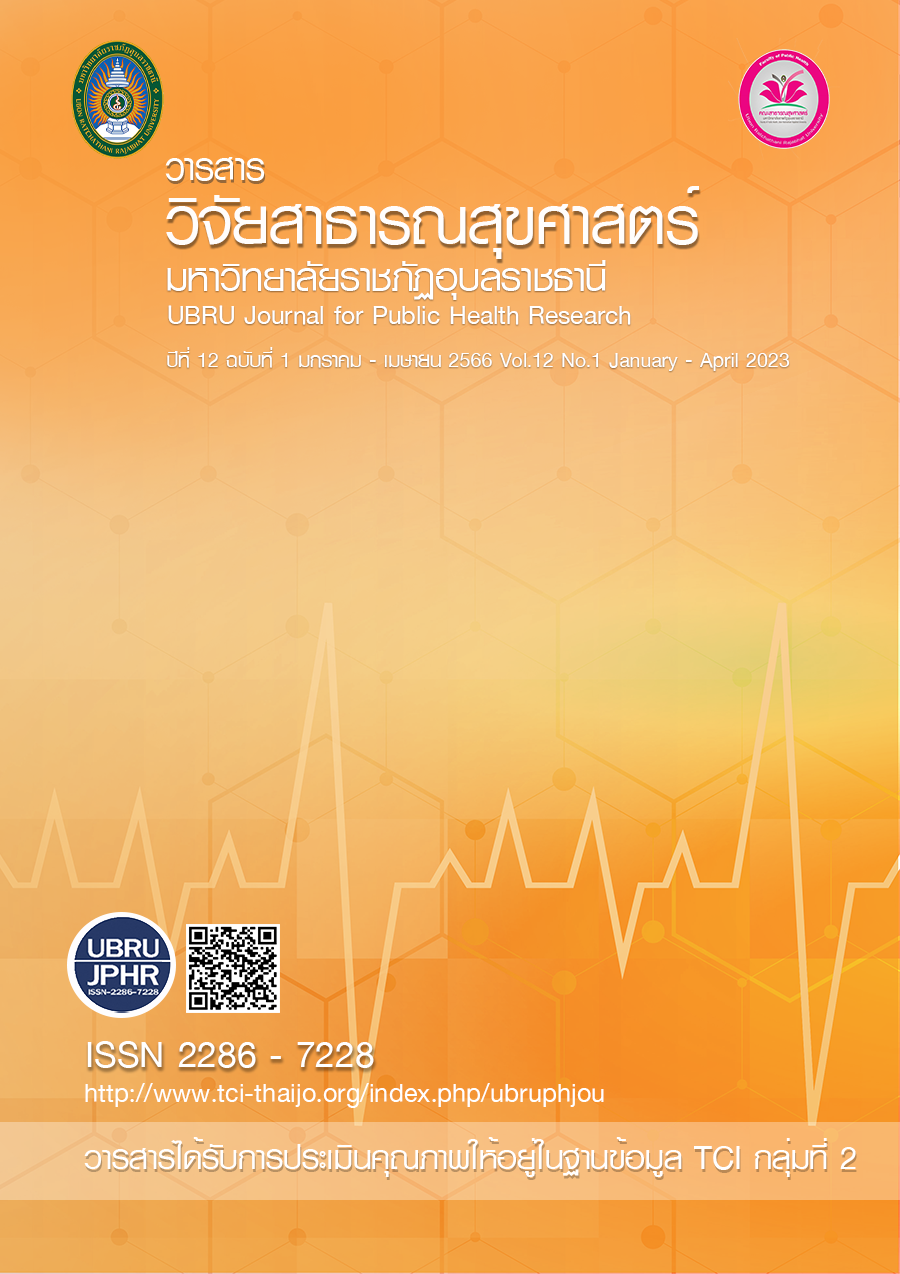Food safety assessment based on sodium hydrosulfite contamination in ready-to-eat and ready-to-cook food samples from various markets in Bangkok Metropolitan Region
Keywords:
Sulfite residue, Sulfite residue, Bleaching agent, food additives, allergy, food additivesAbstract
Contamination of bleach or sodium hydrosulfide in food or food products commonly used in food preservation to inhibit the growth of microorganisms that exceeds the food sanitation standards of the Department of Health, Ministry of Public Health. Not more than 500 milligrams per 1 kilogram of food will affect consumers. This study aimed to study the situation of bleach contamination in 100 food samples from 5 types of food; noodle products, pickled bamboo shoots, fish balls, rice, and bread, 20 samples for each type. Convenient sampling methods was used to collect samples in fresh markets in Bangkok and its vicinity. The samples were tested with a bleach contamination test kit (Alert for sulfile) and the statistics used to analyze the data were descriptive statistics, i.e. number, percentage. The purpose of this study was to determine the situation of sodium hydrosulfite residue in the following foods: noodle products, pickled bamboo shoots, fish balls, rice and bread that may be harmful to consumers' health. According to food sanitation standards, Department of Health, Ministry of Public Health. The samples were collected for the study in various fresh markets in Bangkok and its vicinity. and tested with an alert for sulfite contamination test kit.
The results of the analysis showed that the food samples tested were diverse and completely representative of the food groups of interest in terms of type and quantity. Sodium hydrosulphide contamination from noodle products was found. Four samples of noodles, 2 samples of rice vermicelli and 2 samples of vermicelli, were in the range of 10-100 ppm, representing 20% of total noodle products. and accounted for 4 percent of all samples.
From all test results, it can be concluded that examples of noodle products was found a relative high sodium hydrogen sulfite contamination. Consumers who are at risk of allergic reactions to these compounds should avoid their consumption. In addition, awareness should be raised among food manufacturers and distributors, including the cooperation of relevant personnel who have to carry out food safety inspections and improvements to reduce the risk of contamination of food additives.
References
คลังความรู้ SciMath. (2554). สารฟอกขาวคืออะไร. สืบค้นเมื่อ 10 ธันวาคม 2565, จาก https://www.scimath.org/article-science/item/2059bleach#:~:text=สารฟอกขาวเป็นสาร,ผลิตภัณฑ์%20อาหารอย่างใกล้ชิด
เคมีฟิสิกส์ของสิ่งทอ อาหาร และของรอบตัว. (2561). วิทยาศาสตร์สิ่งทอ อาหาร สีสัน เครื่องสำอาง ของรอบตัว. สืบค้นเมื่อ 17 ธันวาคม 2565, จาก https://textilefoodcolorchem.wordpress.com/?fbclid=IwAR1Xk48MOMMtyJQqJcmNb5pye1RYywGeM6o3rReIbe4_vm9qurCOtj5pD9w
จินตนา กิจเจริญวงศ์, ยุพเรศ เอื้อตรงจิตต์. (2558). การประเมินการได้รับสัมผัสของซัลเฟอร์ไดออกไซด์จากการ บริโภคผักและผลไม้แห้ง นำ เข้าจากต่างประเทศของคนไทย พ.ศ. 2548-2557. วารสารกรมวิทยาศาสตร์การแพทย์. 57 (1) , 58-68. สืบค้นเมื่อ 10 ธันวาคม 2565, จาก https://he02.tci-thaijo.org/index.php/dmsc/article/download/243150/165330
นิตยสารออนไลน์ฉลาดซื้อ ฉบับที่ 191. (ม.ป.ป.). สารฟอกขาว ใน “วุ้นเส้นสด”. สืบค้นเมื่อ 10 ธันวาคม 2565, จาก
https://www.chaladsue.com/article/2474
บี สมาร์ท ซายเอ็นซ์. (2563). ชุดทดสอบซัลไฟต์ในกุ้ง ( Alert® for Sulfites). สืบค้นเมื่อ 10 ธันวาคม 2565, จาก https://www.bsmartsci.com/product/285/ชุดทดสอบซัลไฟต์ในกุ้ง-alert®-for-sulfites
พิมพ์เพ็ญ พรเฉลิมพงศ์, นิธิยา รัตนาปนนท์. (2548). วัตุเจือปนในอาหาร. สืบค้นเมื่อ 17 ธันวาคม 2565,จาก
ราชกิจจานุเบกษา ฉบับประกาศทั่วไป. (ลงวันที่ 6 กันยายน 2547).ราชกิจจานุเบกษา ฉบับประกาศทั่วไป เล่มที่ 121, ตอน พิเศษ 97 ง
รุ่งทิวา รอดจันทร์. (ม.ป.ป.). ซัลไฟต์กับภูมิแพ้. สืบค้นเมื่อ 5 มกราคม 2566, จาก https://www.doa.go.th/psco/wp-content/uploads/2020/06/ซัลไฟต์กับภูมิแพ้.pdf
วัชรี คงรัตน์ (2563) การใช้วัตถุเจือปนอาหารในผลิตภัณฑ์สัตว์น้ำ. กลุ่มตรวจสอบคุณภาพวัตถุดิบและผลิตภัณฑ์สัตว์น้ำ กองวิจัยและพัฒนาเทคโนโลยีอุตสาหกรรมสัตว์น้ำ กรมประมง สิงหาคม 2563 สืบค้น 5 มกราคม 2566, จาก https://www4.fisheries.go.th/local/file_document/20200827154947_1_file.pdf
วัตถุเจือปนอาหาร. (2564). กระทรวงสาธารณสุข. ประกาศกระทรวงสาธารณสุข (ฉบับที่ 281) พ.ศ. 2547
สุภมาศ วัยอุดมวุฒิ. (2561). สารฟอกขาวหรือสารโซเดียมไฮโดรซัลไฟต์ (Sodium hydrosulfite). สืบค้นเมื่อ 10 ธันวาคม 2565, จาก https://assist-impact.net/th/articles/130597-สารฟอกขาวหรือสาร์โซเดียมฮโดรซัลไฟต์9%20%28Sodium%20hydrosulfite%29
สมจิตต์ บวรวัฒนาโสภณ, รรณา ตันยืนยงยงค์. (2544). สารฟอกขาว. วารสารกรมวิทยาศาสตร์บริการ 49(157) , 32-36. สืบค้นเมื่อ 10 ธันวาคม 2565. จาก http://lib3.dss.go.th/fulltext/dss_j/2544_49_157_p32-36.pdf
Asgari G, Mohammadi A. S., Faradmal J., Moradi M. J., Yari K. (2018). The study of Blankit concentration as an unauthorized additive in Hamadan bakeries and risk assessment of food consumption. Pajouhan Scientific Journal. 16 (4), 21-27. Cite 2023 Dec 10. Form https://psj.umsha.ac.ir/article-1-422-en.html
Khan N. and Lively J.A.. (2020). Determination of sulfite and antimicrobial residue in imported shrimp to the USA. Aquaculture Reports.18; 1-24. Cite 2023 Dec 10. Form https://www.sciencedirect.com/science/article/pii/S2352513420306190
Downloads
Published
How to Cite
Issue
Section
License
Copyright (c) 2023 คณะสาธารณสุขศาสตร์ มหาวิทยาลัยราชภัฏอุบลราชธานี

This work is licensed under a Creative Commons Attribution-NonCommercial-NoDerivatives 4.0 International License.
เนื้อหาและข้อมูลในบทความที่ลงตีพิมพ์ในวารสารวารสารวิจัยสาธารณสุขศาสตร์ มหาวิทยาลัยราชภัฏอุบลราชธานี ถือเป็นข้อคิดเห็นและความรับผิดชอบของผู้เขียนบทความโดยตรงซึ่งกองบรรณาธิการวารสาร ไม่จำเป็นต้องเห็นด้วย หรือร่วมรับผิดชอบใดๆ
บทความ ข้อมูล เนื้อหา รูปภาพ ฯลฯ ที่ได้รับการตีพิมพ์ในวารสารนี้ ถือเป็นลิขสิทธิ์ของวารสารฯ หากบุคคลหรือหน่วยงานใดต้องการนำทั้งหมดหรือส่วนหนึ่งส่วนใดไปเผยแพร่ต่อหรือเพื่อกระทำการใดๆ จะต้องได้รับอนุญาตเป็นลายลักอักษรณ์จากบรรณาธิการวารสารนี้ก่อนเท่านั้น


